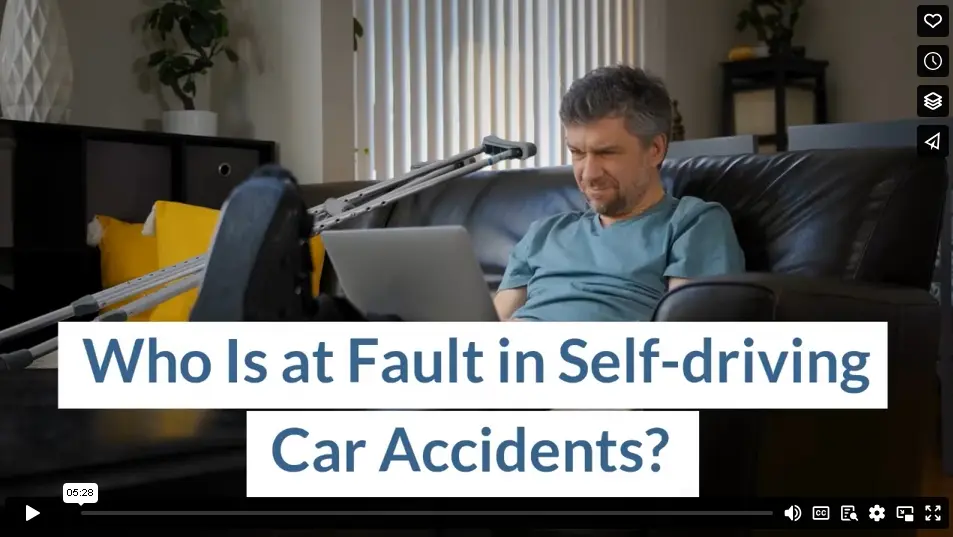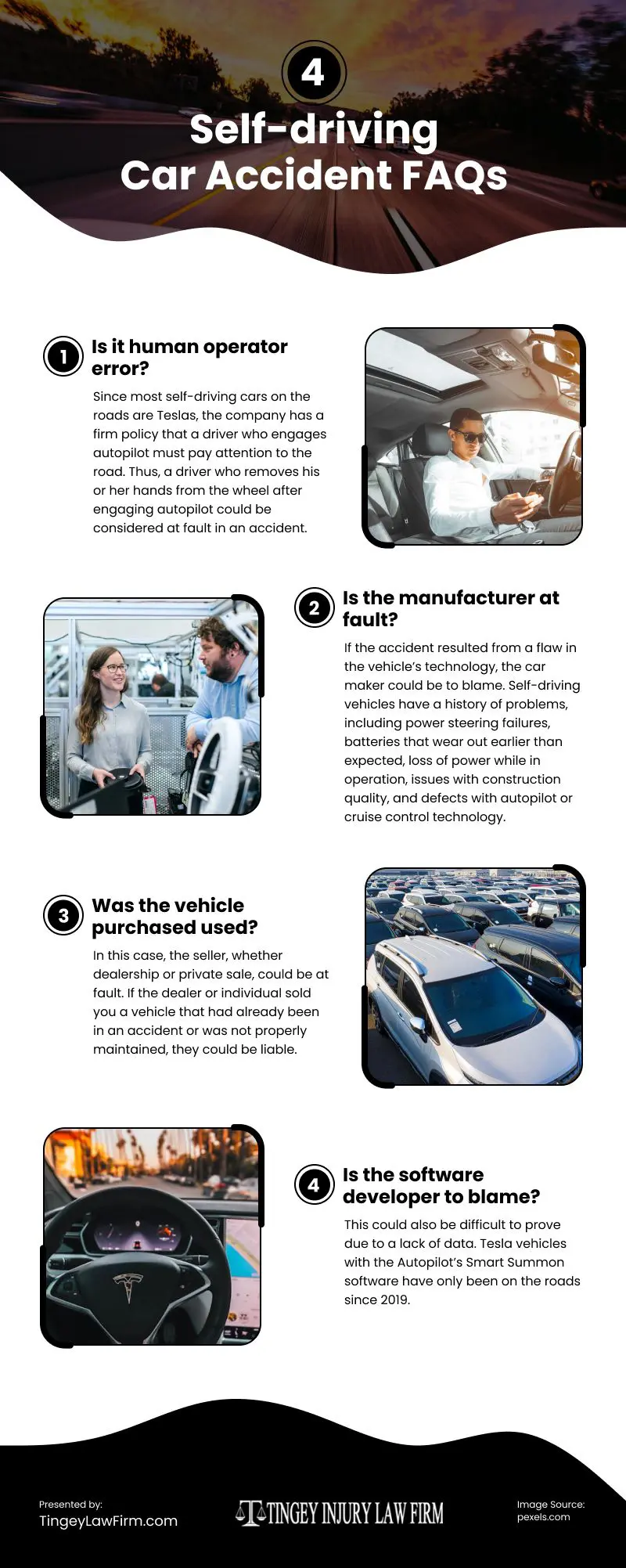Although self-driving cars are becoming more common on American roadways, the technology is still new and has its defects. If you are in an accident involving a self-driving vehicle, either as the driver or if another car collides with yours, determining who is at fault is complex.
In a vehicle without self-driving technology, the driver is usually to blame for an accident. However, with self-driving vehicles, the manufacturer could be at fault. In order to be properly compensated by your auto insurance company, it is important to determine who is to blame for a self-driving vehicle accident.

(Drazen Zigic/Freepik)
Determining Fault
There are four possible scenarios to determine who is at fault in this type of accident:
1. Is it human operator error?
Since most self-driving cars on the roads are Teslas, the company has a firm policy that a driver who engages autopilot must pay attention to the road. Thus, a driver who removes his or her hands from the wheel after engaging autopilot could be considered at fault in an accident.
2. Is the manufacturer at fault?
If the accident resulted from a flaw in the vehicle’s technology, the car maker could be to blame. Self-driving vehicles have a history of problems, including power steering failures, batteries that wear out earlier than expected, loss of power while in operation, issues with construction quality, and defects with autopilot or cruise control technology.
If any of these factors were involved, the manufacturer could be liable. Many accidents involving Tesla’s Autopilot or GM’s Super Cruise systems have reported one of these issues as the cause.
3. Was the vehicle purchased used?
In this case, the seller, whether dealership or private sale, could be at fault. If the dealer or individual sold you a vehicle that had already been in an accident or was not properly maintained, they could be liable.
Teslas are expensive to service, and it is possible the prior owner was negligent with maintenance. However, this could be difficult to prove if your vehicle was functioning normally before the accident.
4. Is the software developer to blame?
This could also be difficult to prove due to a lack of data. Tesla vehicles with the Autopilot’s Smart Summon software have only been on the roads since 2019.
From the list above, you can see that driver error or manufacturer defect are the most common reasons for accidents involving self-driving vehicles, but you must be able to prove which one is at fault. This is why you need an experienced attorney on your side after an accident.
If you are injured in an accident involving a Tesla, you have two years to file a claim. Tesla has an army of attorneys on their side, so you need someone who can negotiate with them and your auto insurer to get you the highest possible compensation.
What to Do After a Self-driving Car Accident
Car accidents can happen without warning, leaving those involved in shock and sometimes seriously injured. It can be difficult to think clearly and know what to do in the moment. If you are in an accident involving a self-driving car, follow the same procedures you would with any type of automobile accident:
1. Call 9-1-1
If you or the other driver or any passengers have been injured, medical attention is your first priority. First responders, including police, fire, and ambulance, will usually arrive at the scene quickly. Allow paramedics to treat anyone involved in the accident, including yourself. Even if you feel fine, you could have internal injuries or whiplash, which you will not feel until later. Allow the medics to examine you.
Safety is also a high priority in the minutes following a collision. To prevent further accidents, move the vehicles to the side of the road, out of traffic, if it is safe to do so without moving anyone who is seriously injured.
2. Gather Information
Assuming you are not seriously injured, collect information to aid the police report.
Get the other driver’s:
- Full name
- Phone number
- Insurance company name
- Insurance policy number
- Driver’s license number
- License plate number
*Consider photographing the driver’s insurance card, license plate, etc., rather than trying to write everything down.
Take photos of the area, including damages to vehicles, traffic conditions, weather and road conditions, street signs and note the presence of any security cameras which may have recorded the accident. Get the contact information of any potential witnesses. If anyone involved in the accident tries to leave the scene before talking to the police, take photos of their license plate so authorities can locate them later.
3. Collect Document/Evidence
Once you are home, request and gather detailed records of medical treatments, car repairs, towing, and other accident-related expenses. Be sure to request a copy of the police report. It will be important evidence for your claim.
4. Contact a Self-driving Car Accident Attorney
Contact a reputable car accident injury lawyer who has experience defending victims of self-driving vehicle accidents. Your attorney will know how to investigate the accident, build an evidence-based case in your favor, and defend your rights against Big Insurance.
Auto insurance companies can be difficult to negotiate with and typically do not respond to claims requesting more than repairing or replacing damaged vehicles. But you may be eligible for other compensation for personal property damages, medical bills, lost wages, pain and suffering, and even wrongful death. An experienced attorney who is familiar with the still-evolving laws regarding self-driving vehicles could make all the difference in helping you obtain a fair settlement after an accident.
At Tingey Injury Law Firm, we have extensive experience defending victims of self-driving car accidents. Our auto accident injury attorneys serve the greater Las Vegas area, including North Las Vegas, Summerlin, and more. Check out our free case analysis tool to find out if you have a viable case for a personal injury lawsuit.
Video
Infographic
Self-driving cars are becoming more common on American roadways. Determining fault can be complicated if you’re involved in an accident with one—whether you’re driving it or another vehicle collides with it. Explore four scenarios for determining fault in this infographic.


